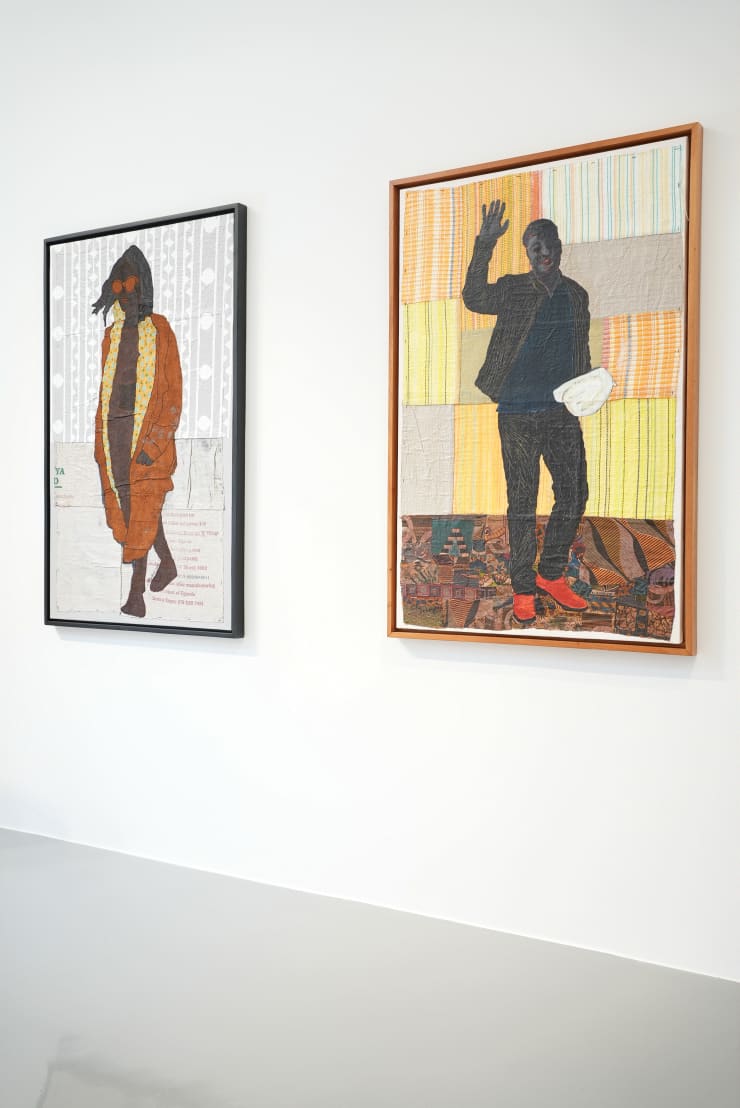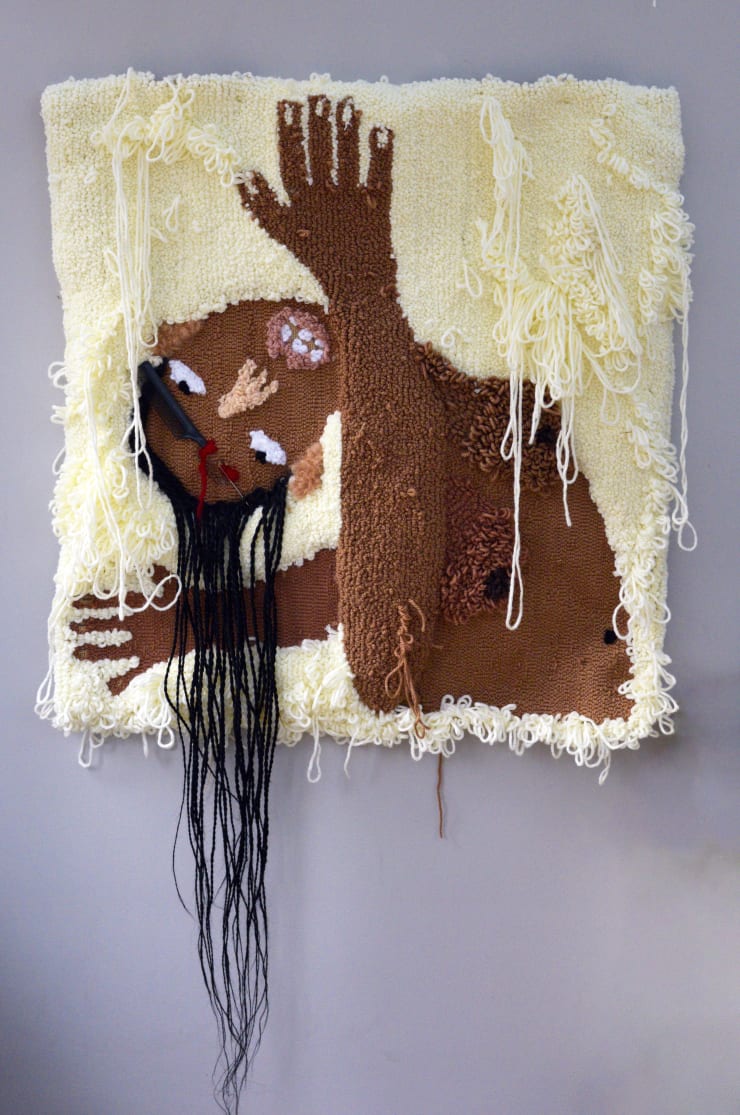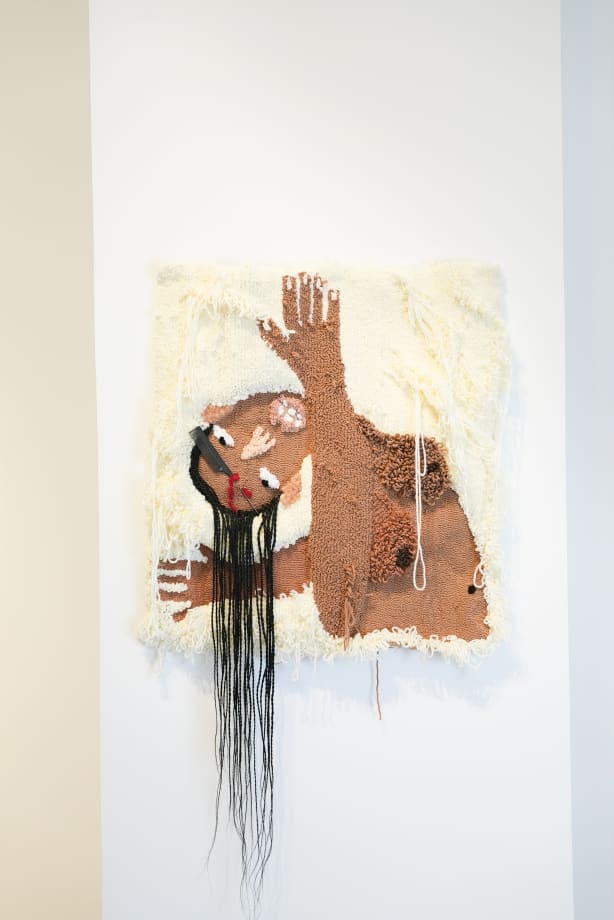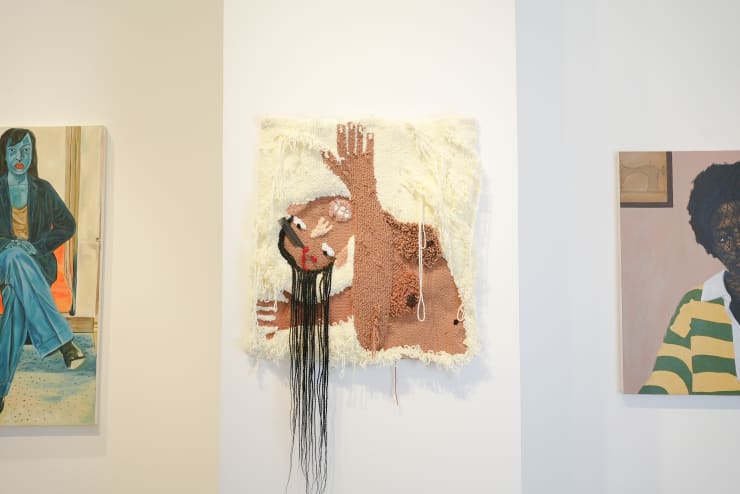IDENTITIES: INAUGURAL GROUP EXHIBITION
Past exhibition
Installation Views
Works
Overview
ANYA PAINTSIL
COLLIN SEKAJUGO
HAMID NII NORTEY
HAWA AWANLERAHMA LHOUSSIG
TOSIN KALEJAYE
GALERIE FARAH FAKHRI is pleased to present Identities, the inaugural exhibition featuring six artists from the African continent and its diaspora. In line with the mission of GALERIE FARAH FAKHRI to support artistic creation and autonomy in Africa and beyond, the collective exhibition Identities explores the concept of identity from an African perspective. Bringing together emerging and established artists from the African continent and its diaspora, they examine the concept and experience of the African people. While valuing African heritage and identity, the exhibition allows visitors to question and challenge dominant narratives around black identity through the captivating works of Tosin Kalejaye, Anya Paintsil, Collin Sekajugo, Hawa Awanle Ayiboro, Hamid Nii Nortey, and Rahma Lhoussig.
In his series for the exhibition, Tosin Kalejaye (born in 1992, Nigeria) shares stories of "ordinary people" situated in ordinary landscapes such as scenes from everyday life. All of Kalejaye's characters bear lines on their skin, a zigzag pattern that the artist calls the "process of glory": when life is punctuated by struggles, joy, and difficulties, one must try different paths before finding their own. Life experiences are depicted as scars not to be forgotten, those that forge resilience after going through many trials. The zigzags actually represent a common thread in the daily life experience of black individuals. Drawn in charcoal over oil paint, they add texture to the artwork, symbolizing the sudden turns that life can take and the layered stories one builds over a lifetime, a transformative experience leading to personal growth. Kalejaye celebrates African identity through portraits of ordinary people, showcasing the multiple facets of the black experience.
The Welsh-Ghanaian artist Anya Paintsil (born in 1993 in Wales, United Kingdom) addresses similar subjects from the perspective of Black women, primarily working with textiles. Her preferred medium is rug and tapestry, skills passed down intergenerationally from women to women in her family for about 100 years. Paintsil uses this medium as a tool linked to feminist history but also as a celebration of women's craftsmanship throughout time. The profound meaning in Paintsil's practice lies in the use of various materials: with synthetic braided hair and sometimes her own hair, the artist represents Black women with traditional hairstyles, a way to revalorize Afro hair—a contentious subject that has long been and still is considered unprofessional by European standards. Working solely with punch needles and no electric tools, the artist presents the medium as a tool of the working class, as opposed to embroidery, once associated with the upper class. The handmade works reflect the care demanded by Afro hair. Paintsil's practice is intuitive and addresses the memories and traumas of her experience as a Black woman born in Wales (United Kingdom).
Collin Sekajugo, a Ugandan artist who received a special mention at the national participations of the Venice Biennale in 2022, develops his artistic practice based on the complex and conflictual question of cultural identity. Born in 1980 in Masaka, Uganda, Sekajugo's personal experience, fleeing the civil war in Rwanda, has deeply influenced his artistic work and played a determining role in his artistic perspective, prompting him to redefine how art transcends geographical, cultural, and political barriers. In this series of works, the artist questions and challenges us about the connections between individuals, communities, and history. Through vibrant colors, bold lines, and layering, the artist incorporates reclaimed materials of Ugandan origin, such as bark cloth, wax and denim fabrics, found objects, and polypropylene market bags. Sekajugo's collages symbolize his relationship with the community: creating a narrative that the audience can identify with. His works thus invite a conversation about sustainability and sustainable development. Collin Sekajugo illustrates cultural blending in the current global context, a contemporary feature he emphasizes by using a reimagined color palette for the skin of his famous subjects, such as Prince Harry and Elon Musk. A series of self-portraits recalls the pandemic period. Thus, Sekajugo invites us to reflect on our place in the world and the importance of awareness of the depth of the bonds that unite human beings.
Similarly, addressing the question of identity, Hawa Awanle Ayiboro, a Ghanaian visual artist born in 1997, explores and draws inspiration from the experiences of African women within patriarchal societies. Coming from a strict family, she has always faced misplaced social expectations and pressure related to marriage and motherhood. For Awanle Ayiboro, painting is an act of emancipation, a personal assertion, and the expression of a deep conviction that she hopes will resonate. As a young woman, the artist uses painting as a means to reject imposed expectations on women like herself. She strives to capture these experiences in her works, inspiring many women to break free from societal constraints. Hawa's distinctive artistic method involves washing her canvases in blue, symbolizing her desire to eliminate an entire world of biases stemming from inequitable and oppressive traditions. This artistic process aims to denounce the restrictions that deprive women of their childhood and the freedom to choose their future, constituting a fundamental violation of human rights.
In the same way, but with a more political undertone, the Ghanaian painter Hamid Nii Nortey (born in 1987, in Ghana) unveils vibrant canvases depicting scenes from everyday life in West Africa. With a colorful and detail-oriented style, the artist creates a realistic portrayal of each figure, where their gestures, emotions, and even clothing reflect a social element and an advocacy for change. His cross-hatching technique used to represent the skin of his characters identifies the artist's signature. The recent incorporation of texts into his paintings—subtle details inviting viewers to get closer to the artwork—opens a conversation about the importance of dismantling detrimental views of poverty and stereotypes about Africa. In each of his works, Nortey addresses contemporary issues and possibilities for change by portraying a modern image of Africa. Nortey's captivating figurative paintings draw inspiration from the rapidly changing social landscape of Ghana and the continent, highlighting its diverse generations and social classes.
Through her artistic creations, Rahma Lhoussig (born in 1996) illustrates a captivating blend of animals, everyday objects, and nature, creating a familiar atmosphere where dissonant elements coexist harmoniously. The works of this Moroccan artist weave enchanting images, intertwining animals, flowers, insects, and tools. Exploring the connection between the body, memory, and meaning, Lhoussig uses various mediums such as oil painting, acrylics, pastels, and colored pencils. Rahma's work highlights emotions as anchors influencing our daily lives. The body, often linked to forces symbolized by ordinary objects, becomes a reflection of unconscious internal conflicts. In the same vein, intentionally unfinished pieces reflect the fragmented nature of memory. In this series of works, figures presented in states of rest, immersion, or hidden behind masks capture moments of submission, fatigue, fragility, and confrontation with surrounding animals and domestic objects. According to the artist, "Our dreams reveal unnoticed and hidden parts of ourselves. My work addresses the unconscious as an allegory, revealing pieces of stories formed from memory, thought, and emotion. The fascination lies in the relationship between the conscious and the unconscious."
Identities defines who we are as individuals and as members of a social group; it is a concept in constant evolution and of paramount importance in our society. Identities challenge the Western gaze on Africa and its diaspora through captivating artworks. The artists offer a contemporary vision of the continent, using art to tell relevant stories about the modern African experience: a way to preserve the past while moving forward. The exhibition successfully celebrates plural identities and heritage within the African continent and beyond, using figurative styles to reclaim black history in the arts and reorient Westernized perspectives from a black point of view.
Press













